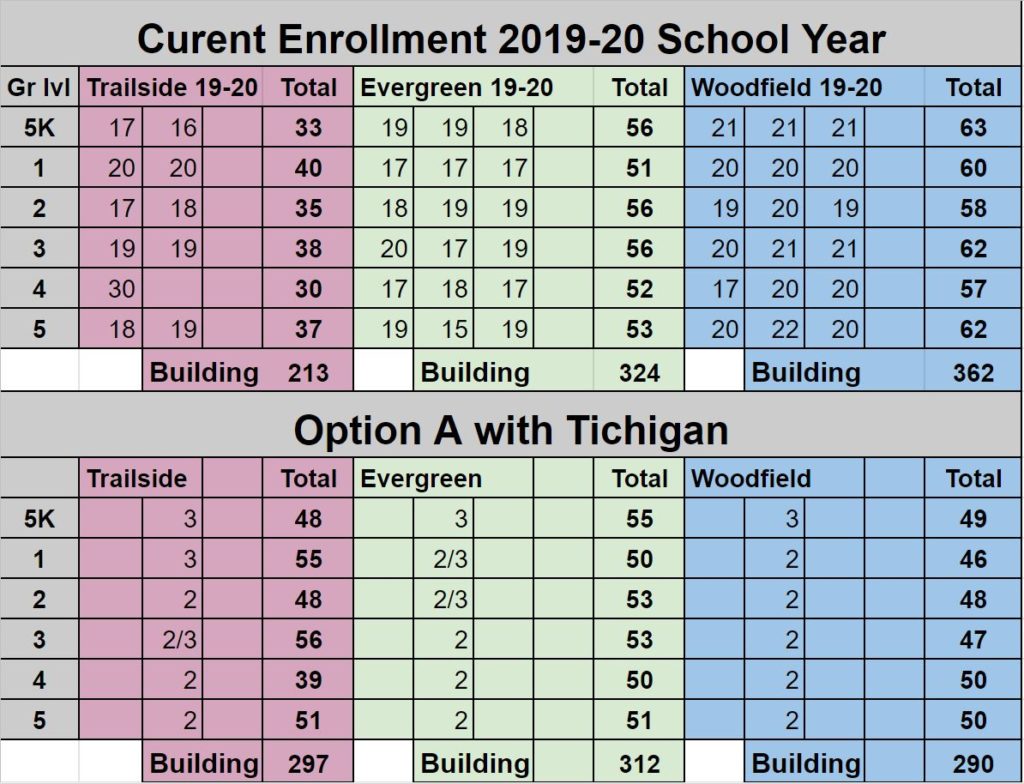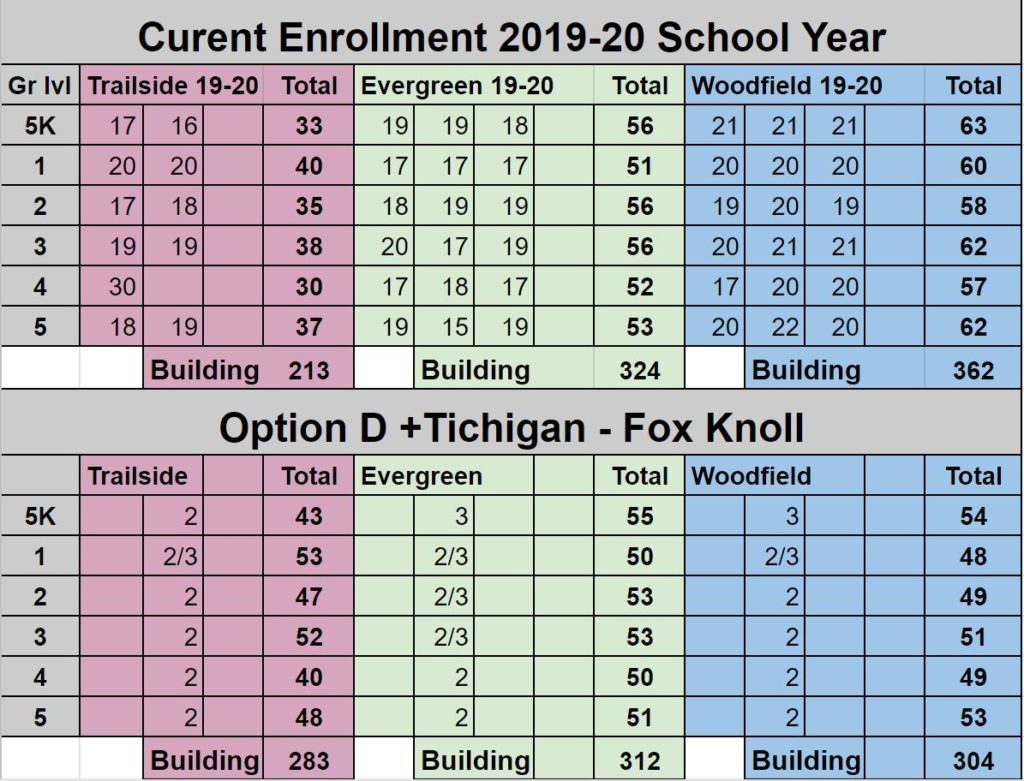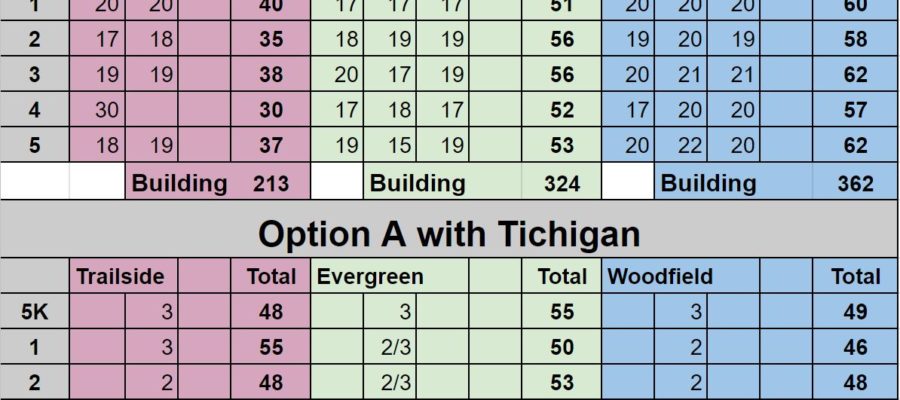At the December 18th meeting the Attendance Committee proposed discussing two new maps at the January 6 meeting. These maps were to be called Map E and Map F, but have been posted as updates to Maps A (Option A + Tichigan) and D (Option D + Tichigan – Fox Knoll) . These maps and the projected change by building and class section have been shared at the elementary school attendance committee webpage.
1) Map Changes Summarized
In both of the new map versions A and D the group of homes on or near N. Tichigan Road would be switched from Evergreen to Trailside (see picture above). The A map revision is called “Option A with Tichigan“.

In the revision of map D the Fox Knoll neighborhood would stay at its current school Woodfield. This appeared to be the case on the original map D, but the attendance data showing this map option having the fewest number of students at Woodfield indicated an error. The corrected map and data table is called “Option D + Tighigan – Fox Knoll“. For those interested in Map B (anyone really????) the committee decided it would no longer be considered.
2) Impact on Building Sections and Class Size
Unfortunately, the data tables show that a large majority of class sizes at Woodfield and Evergreen would increase substantially under any of the map “possibilities” (see the simplified class size data tables below). You will have to do some basic averaging to determine the new class sizes as that was omitted.
Regardless of the map scenario chosen, it can be seen that there is an average increase of approximately 5 students per section in grades 1-5 at Woodfield and grades 3-5 at Evergreen (the range is 3 to 8 more students per section per grade). Grades 1-2 at Evergreen would also have large increases if a possible reduction in sections were to take place (reductions for these sections are listed as an option).
At Trailside the class sizes also increase substantially in almost all sections. The exception is grade 4 that currently has 30 students and will certainly need a second section added with any additions. There would be some other positive class size reductions, but they are few. If you are wondering why class sizes would increase so much after new attendance areas are chosen continue to the next section on Open Enrollment.


3) Open Enrollment
First, it is important to clarify the difference between open enrollment (OE) and an intra-district transfer. An intra-district transfer is simply transferring a WGSD resident student from one building to another. This is always done to help the student/family and at the discretion of the District Administrator. This has nothing to do with open enrollment, which is when a student outside of WGSD wants to come to attend our school district as a “non-resident”.
Any student can apply to open enroll as dictated by Wisconsin State Statute 118-51. During my time following the WGSD school board, I can’t remember a time when they did NOT accept an open enrollment application for a regular education student. We accept these students for one main reason, that being the additional money our district receives. Of course we want to help all families that seek our wonderful district, but it really comes down to the money. Keep in mind that these students open enroll to our district, not a specific building.
The idea is that if we have room in a certain building at the applicant’s grade level there is very little cost to have one more student in a room, yet our district will receive about $8,000 in additional funding. With a net difference of 80 students open enrolling into WGSD, the surplus amounts to more than $600,000 in additional funding for our district that WGSD home owners don’t have to pay. We should not overlook the added strain on classroom teachers when, for example, they have a class size of 23 instead of 20, or the strain on a building administrator that has 40 additional families to serve due to open enrollment students attending their building. Despite these drawbacks, districts across the state regularly accept as many open regular education enrollment students as they can.
Unfortunately for WGSD, open enrollment has created an additional drawback as the district seeks to have all three elementary buildings with a similar enrollment of approximately 300 students. The problem is that most of the grade levels at Woodfield and Evergreen have literally been maxed out. Here is an example of how this happens. Pretend a family in Kenosha of a second grade student applies for open enrollment and requests Woodfield. Normally the school board approves the request. This eventually causes classrooms to reach their maximum. Once the grade level is at the maximum for a preferred school, the school board will still approve the student, but indicate they will be placed at another school, such as Trailside. Remember, open enrollment students are accepted into the District, not an individual school. The family can then accept the position at Trailside, or choose to stay in their resident school district. The data shows that Trailside, even though it is the smallest school by far, has the largest number of open enrollment students in attendance at 52, while Woodfield and Evergreen have 41 and 38 respectively. It should be noted that many open enrollment families are happy to attend Trailside even if it is not their first choice due to the smaller class sizes and excellent reputation.
Now that the District is considering taking long established Woodfield neighborhoods and sending them to Trailside, an unintended consequence arises. The neatly packed classroom sizes at Woodfield, and to some extent Evergreen with the 12 students in the “Tichigan neighborhood”, are decreased, but by only a few students per grade level. The decrease would not appear to be enough to reduce the number of classroom sections from three down to two, but that is NOT what is reflected in the data tables (see above). Most would agree that class sizes of 23 to 26 in grades 1 and 2 are simply too much and that such class sizes can’t possibly be in the best interest of students. While these lower grades are the greatest concern, class sizes would go up substantially at almost every grade level. With the increased shift on the classroom teacher for individual instruction there is good reason for much concern.
Changing attendance areas is always difficult. Keep in mind that class size, while not mentioned specifically, is only one of many factors that the district and school board hope to improve upon. But if you polled teachers, a large number would say that class size is one of the most important factors that impact their ability to meet the needs and best interests of their students.
There will be no simple solution, but it would be unethical to not include open enrollment students when trying to level out the buildings. It is hard to believe that open enrollment students could possibly be grandfathered to their existing school while tax paying families that chose to purchase or build a home in a specific school neighborhood would not be. It is even harder to believe that an entire neighborhood would be forced to move schools because the open enrollment student population at their school created the necessity in the first place.
In order to achieve the numbers desired, some neighborhoods may have to switch schools, but moving some open enrollment students allows for a more efficient way to achieve class sizes that work in the best interests of all students. And as was confirmed by the legal staff at the Wisconsin Association of School Boards, nothing in the law would prevent a school board from doing so.
Finally, what about all of the spirit wear purchased by families at Woodfield and Evergreen? Will there be a trade-in program for those forced to go to Trailside? Those being forced to switch schools will certainly hope so.
Posted by Matt Kranich on 1/5/2020
WGSD Parent

